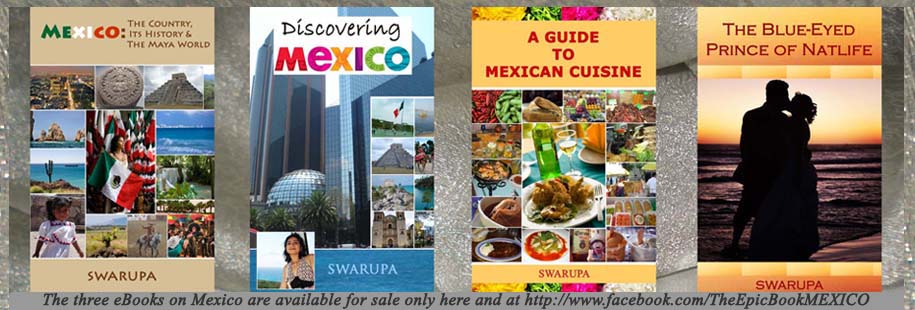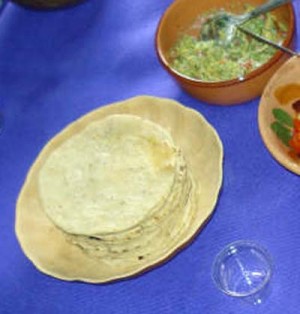Tags
curry, dal, India, Indian cuisine, mexican cuisine, rice, roti
Like Indian cuisine, Mexican cuisine encompasses all the distinct flavors of different cultures and influences to which it has been exposed since ancient times. The culinary traditions of both the countries are a reflection of their rich cultural heritage.
During my nine-month stay in Mexico, I had the opportunity to sample a wide variety of the Mexican cuisine. So, I’m writing this post to share with you my discoveries of popular Mexican food, some of which is quite similar to Indian food.
There are various similarities between Mexican and Indian cuisines right from indigenous cooking tools, common native ingredients to the method of preparations.
The three essential elements common in traditional household kitchens in both the countries are mano y metate (mah-noh eeh meh-tah-teh, grinding stone), molcajete (mohl-kah-heh-teh, stone mortar and pestle) and the comal (koh-mahl, griddle).
Chiles (both, fresh and dried), tamarind and most of the native spices, fruits and vegetables of Mexico are native to India too. Chiles and pungent spices are extensively used in the cuisines of both the countries.
Although differing in taste, the rich Mexican mole (moh-leh) and adobo (ah-doh-bohs) are comparable to the well-known Indian curry in depth and complexity.
Mexican rice dishes are very similar to the Indian pulaos (or pilaus). While Mexican cuisine relies heavily on corn, rice and beans, no Indian meal is complete without rice and dal (dahl). The staple diet of people from the northern states of India, especially Punjab & Haryana, is rajma (red kidney beans) with rice as well as makki di roti, unleavened flat bread made of corn like the Mexican corn tortilla (tohr-teeh-yah).
The sapodilla plum called “chikoo” or “sapota” in India is the “zapote” (the chicozapote or chico of the Maya) in Mexico.
The condiments most commonly found on restaurant tables in Mexico, are the red or green salsas or sauces (made of tomatoes and green chiles), a mix of chopped tomatoes, onions and cilantro, pickled shredded nopales (noh-pah-lehs, prickly pear cactus), lemon slices and bottles of branded salsas offering different levels of spiciness.
Mexican salsa preparations come in various forms – smooth, semi-chunky, or uniformly chopped.
Smooth salsas are like the popular chutneys of India. The basic Mexican salsa consisting of chopped tomato, onion, chiles (usually serranos or jalapeños) and cilantro is commonly prepared and served in homes and restaurants across India.
Tortilla, a thin traditional daily bread is the most common Mexican food and accompanies just about every meal. It is made either from corn or wheat flour but corn tortilla is more popular.
Corn tortillas are prepared by pressing (by hand or by machine) small balls of masa (corn dough).
Wheat tortillas are prepared and rolled out just like the rotis or chappatis of India. These are then wrapped in a cloth and stored in a basket, or in a special plastic container to keep them warm.
Totopos, the hard, thick corn tortillas from the state of Oaxaca (wah-ha-kah) are cooked in a fire oven like the Indian “naan”.
Tortillas are often accompanied by the delicious guacamole (gwah-kah-moh-leh), a traditional Mexican appetizer of mashed ripe avocados, tomatoes, onions, lime juice, salt and cilantro. Restaurants serve guacamole with tortillas or nachos or crackers as free appetizers. In some restaurants, it is freshly prepared right in front of the customer.
I hope you have enjoyed this post as much as I have enjoyed putting it together for you. Very soon, I’ll be back with the next part of this post, “Similarities between Mexican and Indian Cuisines – Part II“, which is equally interesting.
If you think this is good quality information and people would benefit from it, go ahead and share it with the rest.
If you missed my previous post on Mexican cuisine, then click here.
You can read all about Mexican Cuisine in my book “A Guide to Mexican Cuisine” which is a part of my soon-to-be-published three-book series on Mexico.
Before I say “bye” to you all, here’s a racy track by Ricky Martin : She Bangs (Spanish Version) …Enjoy 🙂
See you soon…keep smiling 🙂
Next Posts:
Similarities between Mexican and Indian Cuisine – Part II
Similarities between Mexican and Indian Cuisine – Part III







Greetings. Thanks for visiting my blog. I enjoyed your post. Do you have any photos?
LikeLike
Greetings. Thanks for visiting my blog. I enjoyed your post. Do you have any More photos?
LikeLike
Greetings and thanks to you too for visiting my blog 🙂 I’m so glad you’ve enjoyed your visit here as much as I did at your blog. I do have some more photos besides the ones I’ve shared here and in the subsequent posts.These are all a part of my soon-to-be-published book “A Guide to Mexican Cuisine” which again is a part of my three-book series on Mexico. 🙂
LikeLike
Interesting, thank you.
LikeLike
And to you too, thank you very much 🙂
LikeLike
This was interesting, I love both Indian and Mexican food. Actually I enjoy food in general.
LikeLike
Hi, Kimmie. Thank you for visiting my blog and for your kind comment. I’m glad to know that you enjoyed my post. Do keep visiting…cheers 🙂
LikeLike
Exceptional blog.The Indian cuisine is unique because of the special flavors and spices .Last week we were at long Beach California we had a delicious tandori chicken with garlic bread.Thank you for the visit and liking my post (The Armenian Genocide..) Blessings and more success.jalal
LikeLike
Hi Jalal 🙂 Thank you so much for such kind words of appreciation. I’m happy to know that you love Indian cuisine too. Thank you for visiting my blog..do keep visiting…cheers 🙂
LikeLike
sounds very interesting! there does always seem so much similar beyond the tomatoes and the overall spiciness 🙂
LikeLike
Hi, Bhavani 🙂 Thanks for visiting my blog and for your kind comments.
You’ll discover many more similarities in both cuisines after you read all the three parts…enjoy and do keep visiting…cheers 🙂
LikeLike
Thanks Swarupa for visiting my blog and I found your blog will be more charming to my wife(I have already shared the link to her), and let me revert back to you after the ‘lab test part’ 🙂
LikeLike
Hi, Shibu. You’re welcome. Thanks for visiting my blog and for sharing it with your wife.
Do keep visiting….cheers 🙂
LikeLike
Swarupa, I grew up in the US Southwest, so New Mexican cuisine is a large part of our diet. We travel to India regularly to teach (my wife leaves for Chennai today), so we have learned to make several south Indian dishes. There is a good deal of similarity between the two cuisines, and I am enjoying your thoughts on this.
LikeLike
Hi Michael! Thanks for visiting my blog and for your kind comments! Very pleased to read about you and your wife. Chennai is my favourite South Indian city. Wishing her a pleasant journey! Read about your work on your interesting blog. I’d be happy to meet and exchange thoughts if you happen to visit Mumbai. Cheers 🙂
LikeLike
It is truly a nice and useful piece of information. I am happy that you
just shared this helpful information with us. Please stay us informed like
this. Thanks for sharing.
LikeLiked by 1 person
Hi and thank you so much 🙂 Do keep visiting me. Cheers 🙂
LikeLike
Very thanking you…mam, this research which is done by you…is very helpful for us give me a lot knowledge about the cuisines between Indian and Mexican cuisines as well as differences.
LikeLike
Pingback: Mexican American culture-An Immigrant's Perspective - A Primer on American Culture, Slang and Cliches
Hi Yuvraj, Thanks so much for visiting my blog and for your kind comments. Best 🙂
LikeLike